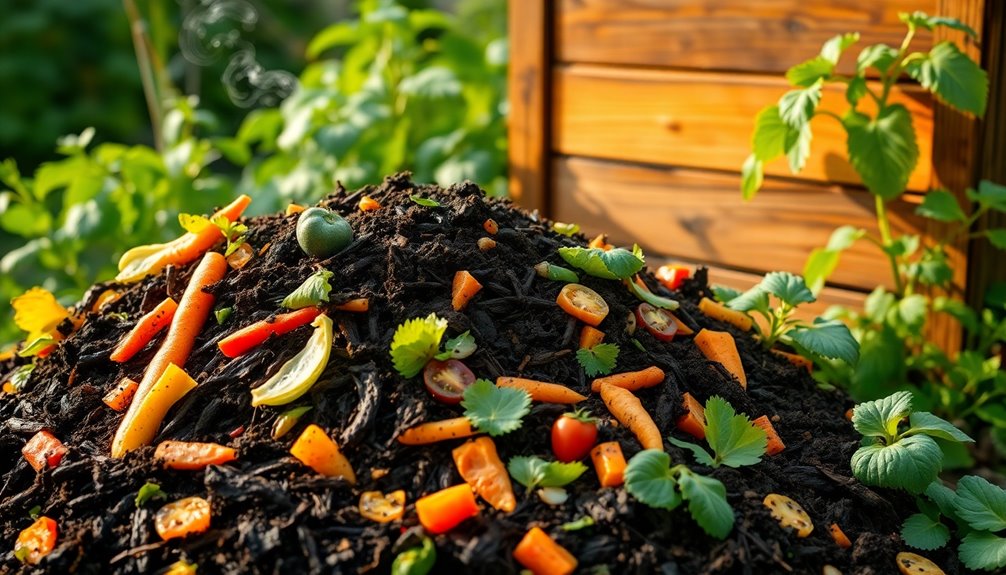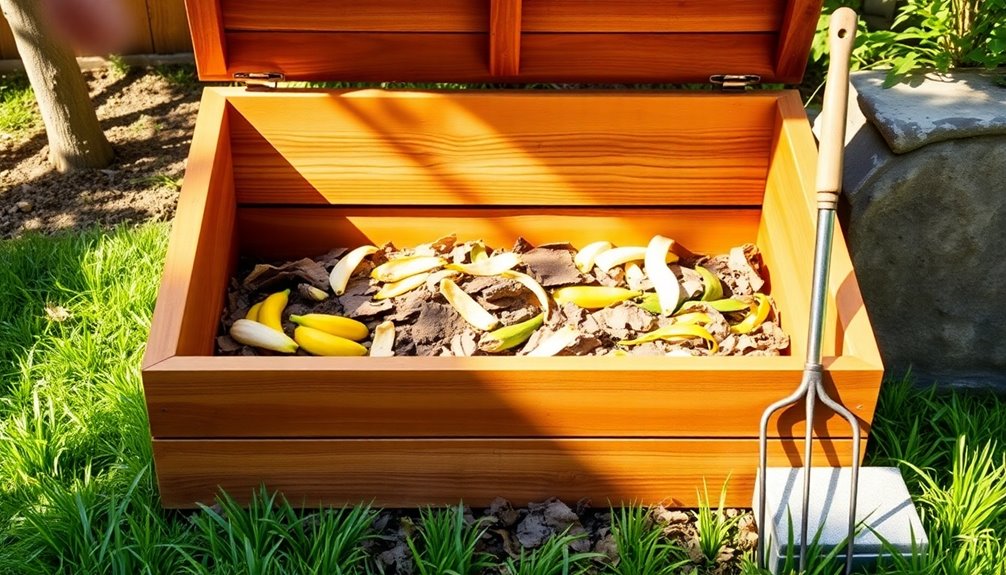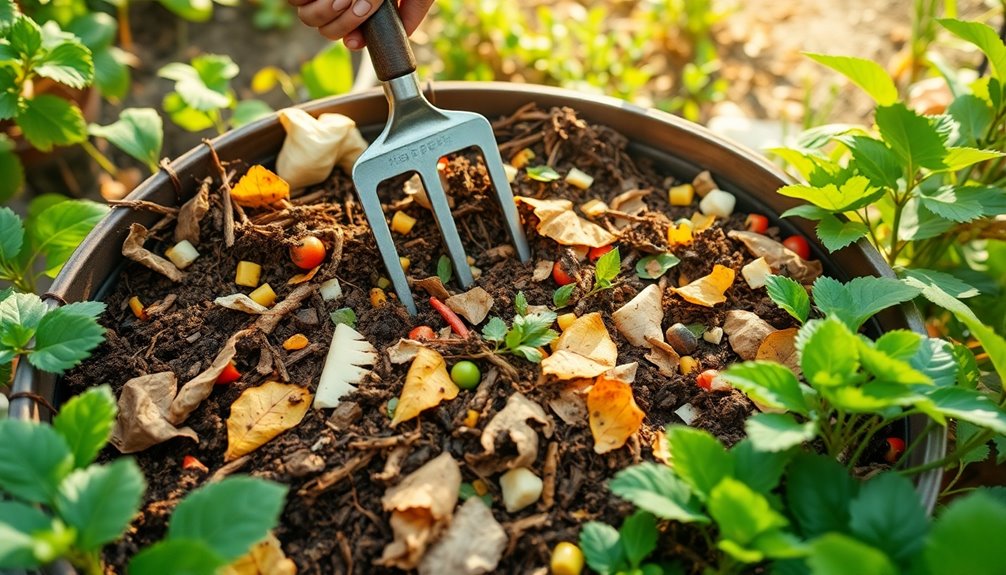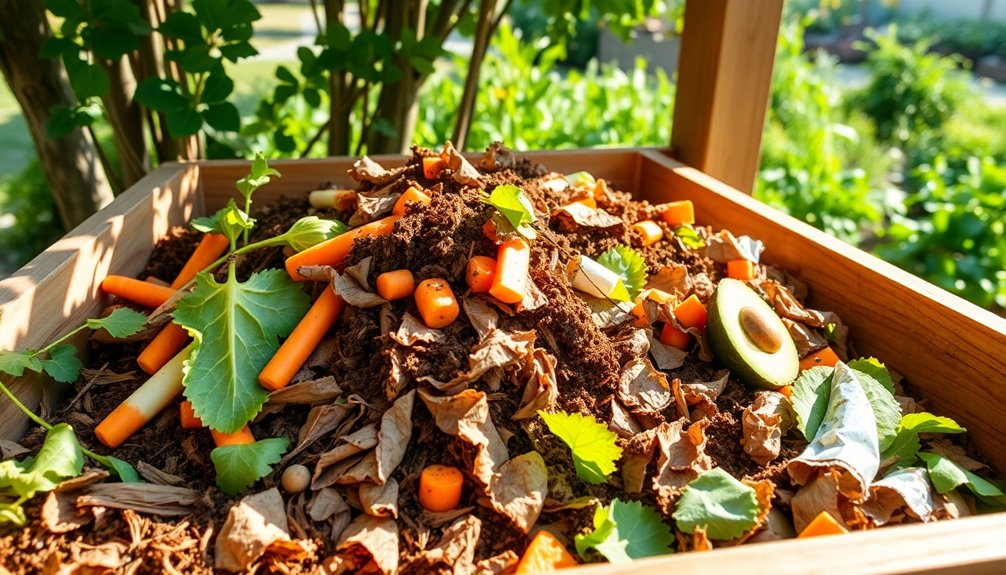Composting is a simple and rewarding way to reduce food waste while enriching your garden soil. Start by setting up a compost bin with a mix of green materials like fruit scraps and coffee grounds, and brown materials like dry leaves and cardboard. Aim for a balanced ratio to encourage decomposition. Regularly turn the pile and monitor moisture levels to prevent odors and keep things decomposing efficiently. By composting, you not only minimize waste but also create a nutrient-rich environment for your plants. Curious about the common pitfalls and more benefits? There's plenty more to discover!
Key Takeaways
- Start with a balanced mix of greens (like fruit scraps) and browns (such as dry leaves) for effective composting.
- Maintain a compost pile size of at least three feet by three feet for optimal decomposition.
- Regularly turn the compost to aerate it and speed up the breakdown process.
- Monitor moisture levels and adjust as necessary to prevent odors and promote healthy decomposition.
- Engage with local composting initiatives to share knowledge and reduce food waste in your community.
Understanding Composting Basics

Composting is a transformative process that turns your food scraps and yard waste into nutrient-rich soil, benefiting both your garden and the environment. When you understand the basics of composting, you'll see how easily you can contribute to a sustainable lifestyle while enhancing your garden's health.
To start, you'll want to gather the right composting materials. Think of your compost pile as a layered cake. You need a mix of green materials, like fruit and vegetable scraps, and brown materials, like dried leaves and cardboard. This balance is pivotal for creating a thriving compost pile. The greens provide nitrogen, while the browns supply carbon, and together they fuel the decomposition process.
As you build your compost pile, aim for a size of at least three feet by three feet. This size allows it to heat up properly, breaking down the materials efficiently. Additionally, incorporating plant-based ingredients into your compost can enhance nutrient content and improve soil health.
Turn your pile regularly to aerate it, which speeds up decomposition and keeps odors at bay. Don't worry if you make mistakes; composting is forgiving, and you'll learn as you go.
What Can You Compost?

Gathering the right materials is vital for a successful compost pile. Knowing what you can compost not only makes the composting process easier but also helps you feel connected to a community dedicated to reducing waste.
You'll want to focus on two main types of composting materials: greens and browns.
Greens are your nitrogen-rich materials, which include fruit and vegetable scraps, coffee grounds, eggshells, and grass clippings. These ingredients break down quickly and provide essential nutrients for your compost.
On the other hand, browns are carbon-rich materials like dry leaves, cardboard, and straw. These help aerate your pile, promoting a healthy decomposition process.
It's important to maintain a balanced ratio of greens to browns, ideally about 1:3. Too many greens can lead to a smelly, soggy mess, while too many browns can slow down the composting process.
You can also add small amounts of yard waste, such as small branches and weeds, but steer clear of diseased plants. Additionally, maintaining a healthy compost pile can help combat chronic inflammation, which is often linked to underlying health conditions that may affect overall well-being.
How to Set Up a Compost Bin

Setting up a compost bin is an exciting step toward reducing food waste and nurturing your garden. You're about to create a sustainable cycle that benefits both your kitchen and your plants. First, focus on choosing the right bin. You can select from various options like store-bought bins, DIY bins made from pallets, or even simple piles. Consider what works best for your space and needs.
Next, pay attention to location considerations. Your compost bin should be placed in a convenient, accessible area, allowing you to easily toss in kitchen scraps and yard waste. Choose a spot that's:
- Well-drained: Avoid areas that collect water to prevent your compost from becoming soggy.
- Partially shaded: Some sun is great for speeding up decomposition, but too much can dry it out quickly.
- Close to your kitchen: The easier it's to reach, the more likely you'll be to use it regularly.
Once you've selected the right bin and found the perfect spot, you're ready to start composting! Layer your greens (like fruit scraps and vegetable peels) with browns (such as dry leaves and cardboard) to create a balanced mix. You'll be contributing to a healthier environment while enjoying the satisfaction of reducing waste.
Maintaining Your Compost

Maintaining your compost pile is crucial for turning kitchen scraps and yard waste into nutrient-rich soil. To safeguard your compost thrives, you'll want to monitor its condition regularly.
Start by checking the moisture level; it should be damp but not soggy. If it's too dry, add some water or more green materials, like vegetable scraps. Conversely, if it's too wet, mix in dry materials like shredded newspaper or leaves.
One common issue you might face is odors. If your compost smells bad, it could be due to an imbalance of greens and browns or insufficient aeration. To troubleshoot odors, mix the pile well to introduce oxygen and consider adding more carbon-rich materials. If the smell persists, check for overly wet areas and adjust moisture levels accordingly.
Controlling pests is another aspect of maintenance. While some insects are beneficial, unwanted critters can be a nuisance. To deter pests, bury food scraps deep within the pile and cover them with a layer of brown materials. You can also use a compost bin with a lid to minimize access for rodents and other animals. Additionally, regular monitoring of your compost can help ensure effective results in transforming waste into valuable soil.
Common Composting Mistakes

Many beginners make at least three common composting mistakes that can hinder the process and lead to unsatisfactory results. By avoiding these pitfalls, you can create a thriving compost that benefits both your garden and the environment.
Firstly, neglecting proper turning is a frequent error. Rotating your compost regularly helps aerate the materials, speeding up decomposition. If you let it sit without turning, you risk creating a dense, anaerobic pile that produces foul odors instead of the rich, earthy smell you desire.
Secondly, many people struggle with odor control. If you notice a strong, unpleasant smell emanating from your compost, it's often a sign of imbalance. Make sure you're adding a mix of green (nitrogen-rich) and brown (carbon-rich) materials. Too many greens can lead to a smelly pile, while too many browns can slow down the process.
Lastly, overloading your compost with large items is another mistake. Breaking down materials into smaller pieces helps them decompose faster. This not only encourages proper turning and aeration but also reduces the chances of odor problems. Additionally, some studies have shown that maintaining a balanced compost can significantly enhance nutrient availability for plants, leading to healthier garden growth, as noted by research from Emory University School of Medicine.
To summarize, keep these tips in mind to improve your composting experience:
- Rotate your compost regularly for proper aeration.
- Balance green and brown materials for effective odor control.
- Chop larger items into smaller pieces for quicker decomposition.
Benefits of Composting

Composting offers numerous benefits that extend beyond merely reducing food waste; it enriches your garden and promotes a healthier environment. By turning your kitchen scraps and yard waste into nutrient-rich soil, you're not only minimizing landfill contributions but also creating a sustainable living practice that supports organic gardening.
Here's a quick overview of the benefits you gain from composting:
| Benefit | Description | Impact on You |
|---|---|---|
| Environmental Impact | Reduces greenhouse gases and landfill waste. | You contribute to a healthier planet. |
| Nutrient-Rich Soil | Enhances soil quality and fertility. | Your plants thrive with less effort. |
| Cost Savings | Decreases the need for chemical fertilizers. | You save money on gardening expenses. |
| Community Engagement | Encourages local composting initiatives. | You connect with others who care. |
Composting creates a positive feedback loop; as you cultivate your garden with nutrient-rich soil, you're fostering a symbiotic relationship with nature. This practice not only reduces your environmental footprint but also enhances your gardening experience, making it more rewarding and fulfilling. Additionally, composting aligns with the principles of plant-based diets, further contributing to a sustainable lifestyle.
When you embrace composting, you're joining a community of like-minded individuals who value sustainability and environmental stewardship. Every small step you take contributes to a larger movement toward a healthier planet. So, get started today—your garden and the environment will thank you!
Frequently Asked Questions
Can Composting Attract Pests Like Rats or Raccoons?
Yes, composting can attract pests like rats or raccoons if not managed properly. However, you can implement effective pest prevention strategies to keep your compost pile safe.
Use enclosed bins, balance green and brown materials, and avoid adding meat or dairy. These composting solutions help minimize odors and deter unwanted visitors.
How Long Does It Take for Compost to Mature?
It typically takes three to six months for compost to mature, depending on various factors. If you turn your compost regularly—ideally every few weeks—you'll speed up the breakdown process.
Maintaining an ideal composting temperature of 130°F to 160°F also helps, as it fosters microbial activity. Keep an eye on moisture levels and add materials as needed to create a balanced mix, and you'll soon have rich, dark compost to enrich your garden!
Is Composting Safe for Indoor Use?
Think of indoor composting as a thriving garden in a small pot; it's manageable and rewarding.
Yes, composting is safe for indoor use, especially with modern indoor composting bins designed to control odors. These bins often feature airtight seals and carbon filters, ensuring your space stays fresh.
Can I Compost Meat or Dairy Products?
You might be wondering if you can compost meat or dairy products. While it's tempting, composting restrictions often advise against it due to the risk of attracting pests and creating odors.
Instead, consider alternative disposal methods like using a food waste digester or a local composting service that accepts these items. By choosing these options, you can still contribute to reducing waste while keeping your compost pile healthy and pest-free!
What Tools Do I Need for Composting?
To start composting effectively, you'll need a few essential tools. First, grab a composting container for collecting your kitchen scraps and yard waste. This keeps everything tidy and ready for composting.
Next, invest in turning tools like a pitchfork or compost turner to aerate your pile, promoting faster decomposition.
With these tools, you're well on your way to creating nutrient-rich compost while contributing to a sustainable community. Happy composting!
Conclusion
Composting is an easy and rewarding way to reduce food waste while enriching your garden. Did you know that about 30% of the food supply in the U.S. goes to waste? By composting, you can turn that waste into valuable nutrients for your plants. So, grab those kitchen scraps and start your composting journey today. Not only will you help the environment, but you'll also create a healthier, more vibrant garden!



